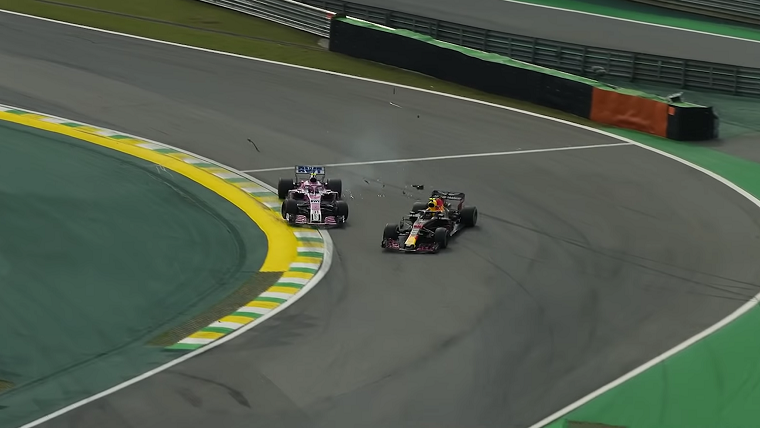Analysis of the Verstappen/Ocon Crash
Red Bull Racing’s Max Verstappen was poised to win yesterday’s 2018 Brazilian Grand Prix when he clashed with Force India’s Esteban Ocon, the 22-year old Frenchman against whom he had driven in Formula 3.
Ocon was already lapped, but strove to un-lap himself, as the regulations allow. He was on a quicker tire and sought some breathing room to put in fast laps and make up time in his own race against the midfield, something he couldn’t do while stuck behind the race leader.
He got next to Verstappen at turn 1, and while still halfway alongside as they came up to turn 2, Verstappen took the usual racing line and made inevitable contact, sending both cars into a spin. Verstappen lost the lead and with damage to his car’s floor and thus aerodynamic performance, he also lost any real chance of regaining it.
It was a huge, race-impacting incident and virtually everyone watching the Formula One Grand Prix immediately and nigh-universally laid the blame at Ocon’s feet. What in the world was he thinking, a lapped driver, going wheel-to-wheel with the race leader?
Collision Center: The best place to go after a car crash
I didn’t think it was so clear cut. Had they been racing for position, Verstappen would have been at fault, as Ocon was firmly alongside him and would have earned the right to the particular piece of track where contact was made. Crucially, however, they were not racing for position, and while drivers are entitled to try and un-lap themselves, the importance of the leader’s race will always be weighed more strongly than that of a backmarker’s race.
Charlie Whiting, FIA race director, thinks the same. “He’s absolutely allowed to un-lap himself,” he said about Ocon. “That’s clear, it’s happened many times in the past. However, you would expect it to be done safely. More to the point it should be done cleanly and absolutely without fighting. He shouldn’t be fighting to get past.”
It’s relevant that even the quickest lapped cars are rarely quick for long. It is, after all, rarely if ever the case that a backmarker is consistently faster than the race leader (if they were capable of this, they would be not backmarkers but frontrunners). As such, it’s usually the case that if a backmarker is fast enough to un-lap itself, it tends to remain in the vicinity of the leading cars and gets lapped again soon thereafter. This slows everyone down and thus it is usually in everyone’s best interest that they not bother un-lapping themselves in the first place.
Leasing: Why it’s better than buying
Though it’s unfortunate for backmarkers, the expectation is ultimately that they should always jump out of the way and make life as easy as possible for the leaders, even at the cost of their own race. As someone who has been in Verstappen’s shoes many times in online simulation racing games, I’m inclined to agree with that line of thought. Racy lapped cars are the bane of my existence when I’m leading a race, as they are often the only unpredictable factor in the way of my victory.
But because of that unpredictability and of the cost of a clash, I always treat lapped cars with caution. I would posit that even if Verstappen was entitled to the racing line as a result of being the race leader, he should have never taken the risk of assuming Ocon would jump out of the way, especially as Ocon had made it clear he was trying not to do so. Five-time champion Lewis Hamilton made the same case in the post-race cooldown room when he reminded Verstappen that he had had the most to lose in that situation.
But the argument in favor of Verstappen is fairly clear: even if Verstappen initiated the contact, Ocon should never have been there in the first place. Because he was only halfway and not fully alongside Verstappen, the young Dutchman did not see him and assumed, because of the general consensus that lapped cars should not interfere with leading cars, that he could safely stay on the racing line.
Recap: 2018 Brazilian Grand Prix
Racing drivers make all kinds of similar assumptions throughout a race, many without which wheel-to-wheel racing would simply be impossible — when another driver will brake and steer, for instance. And assuming a lapped car would not interfere is reasonable and well within Verstappen’s right, which is why the stewards ultimately sided with him and gave Ocon a 10-second stop-and-go penalty.
Nonetheless, being in the right is a small consolation for losing the race. Because Ocon had made it clear he was trying to race Verstappen, I think Verstappen should not have made such an assumption and left more room. He would have then won the race and have his own caution to thank for it. Instead, he finished second and will be required to perform two days of public service, “at the direction of the FIA,” for beginning a physical altercation with Ocon after the race, in the weigh-in room.
Verstappen is an extremely good driver currently held back by a slight lack of maturity and a propensity for hotheadedness. If he can put that behind, he’ll have everything he needs to be an all-time great.
Kurt Verlin was born in France and lives in the United States. Throughout his life he was always told French was the language of romance, but it was English he fell in love with. He likes cats, music, cars, 30 Rock, Formula 1, and pretending to be a race car driver in simulators; but most of all, he just likes to write about it all. See more articles by Kurt.


